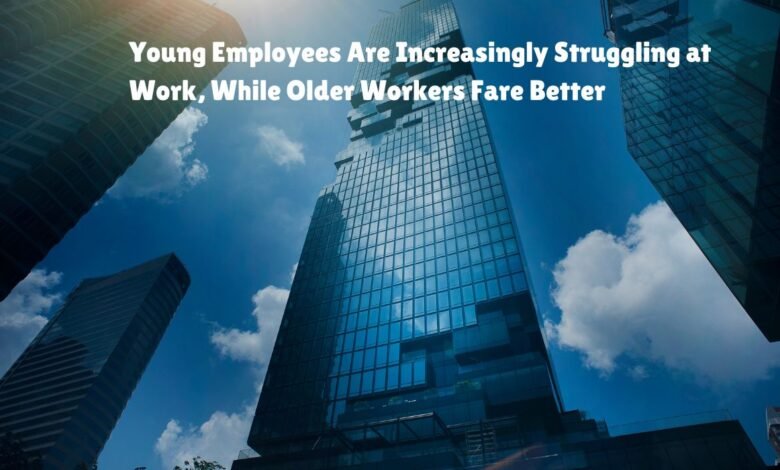Young Employees Are Increasingly Struggling at Work, While Older Workers Fare Better
Young employees are increasingly struggling at work, while older workers fare better. Explore the reasons behind this workplace trend.

The modern workplace has undergone significant transformations over the past few decades. One of the most noticeable trends is the disparity in workplace performance between young employees and their older counterparts. Recent studies and statistics reveal that young employees are increasingly struggling to adapt and thrive in professional environments. According to a report by the McKinsey Global Institute, young workers are 30% more likely to experience job dissatisfaction compared to older employees. Similarly, a survey conducted by Gallup indicates that only 29% of millennials feel engaged at work, in contrast to 45% of baby boomers.
Understanding these dynamics is crucial for both employees and employers. For young employees, recognizing the challenges they face can help them seek out the necessary resources and strategies to improve their workplace performance. On the other hand, employers can benefit from understanding these trends by implementing policies and practices that support their younger workforce, thereby enhancing overall productivity and morale.
Several factors contribute to this trend, including rapid technological advancements, differing work expectations, and evolving workplace cultures. Young employees often find themselves navigating complex digital landscapes while simultaneously trying to meet high performance expectations. In contrast, older workers, who have had the advantage of gradual adaptation and accumulated experience, seem to fare better in these environments.
By examining these factors in detail, we can gain a comprehensive understanding of why young employees are struggling and what can be done to bridge this gap. A deeper insight into these issues will not only help in fostering a more inclusive and supportive work environment but also in leveraging the unique strengths that both young and older employees bring to the table.
Key Challenges Faced by Young Employees
Young employees entering the workforce often face a myriad of challenges that can significantly impact their job satisfaction and performance. These challenges typically stem from a combination of inexperience, high expectations, and the pressure to quickly adapt to unfamiliar corporate cultures. Understanding these obstacles is crucial in addressing the root causes of stress and dissatisfaction among young professionals.
One of the primary challenges is the lack of experience. Young employees, often fresh out of college or with limited professional exposure, may struggle with the practical application of theoretical knowledge. This gap can lead to feelings of inadequacy and uncertainty, making it difficult to perform tasks efficiently or to meet the expectations of their superiors.
Another significant challenge is the high expectations placed on young employees. Organizations frequently expect new hires to deliver results swiftly, often under tight deadlines. This can create an overwhelming pressure to perform, leading to stress and burnout. Young employees might also feel the need to prove themselves constantly, which can result in overworking and a compromised work-life balance.
Adapting to corporate culture is another hurdle. Each organization has its own set of norms, values, and unwritten rules, which can be daunting for young employees to navigate. The pressure to blend in and conform to these cultural expectations can be overwhelming, especially when they conflict with personal values or beliefs.
These factors collectively contribute to a challenging work environment for young employees. The key challenges can be summarized as follows:
- Lack of practical experience and skills.
- High expectations and pressure to perform.
- Difficulty in adapting to corporate cultures.
Addressing these challenges requires a multifaceted approach, including comprehensive onboarding programs, mentorship opportunities, and fostering a supportive work environment that encourages growth and development. By acknowledging and mitigating these issues, organizations can help young employees thrive and succeed in their professional journeys.
Advantages Older Workers Have
In many contemporary workplaces, older workers tend to fare better compared to their younger counterparts due to several key factors. One of the primary advantages older employees possess is their accumulated experience. Over the years, they have developed a deep understanding of their industry, refined their skills, and learned from past mistakes. This extensive experience allows them to navigate complex situations with ease and make informed decisions, contributing significantly to their overall effectiveness and reliability.
Another notable advantage is the well-developed professional networks that older workers have cultivated throughout their careers. These networks provide them with valuable connections and resources that can facilitate problem-solving, collaboration, and career advancement. Being able to leverage a robust network often leads to more opportunities, smoother project execution, and the ability to mentor younger employees, further solidifying their position within the organization.
Moreover, older workers generally have a clearer understanding of workplace dynamics. Having spent considerable time in various organizational environments, they are adept at recognizing and adapting to the informal rules and cultural nuances that govern workplace interactions. This insight helps them navigate office politics more effectively, communicate more strategically, and build stronger relationships with colleagues and superiors.
The table below presents a comparison between the strengths and weaknesses of young and older employees:
| Aspect | Young Employees | Older Employees |
|---|---|---|
| Experience | Limited, learning phase | Extensive, seasoned |
| Professional Networks | Developing | Well-established |
| Workplace Dynamics | Still learning | Deep understanding |
| Adaptability | High, tech-savvy | Moderate, adaptable |
| Energy Levels | High | Moderate |
While young employees bring fresh perspectives and high energy levels, the advantages older workers have in terms of experience, networks, and understanding of workplace dynamics cannot be understated. Balancing these strengths within a team can lead to a more effective and harmonious work environment.
The Role of Mentorship and Support Systems
In the contemporary workplace, mentorship and support systems have become indispensable tools for fostering the growth and development of young employees. These mechanisms are vital in helping young professionals navigate the myriad challenges they face, from understanding organizational culture to mastering job-specific skills. Older workers, with their extensive experience and institutional knowledge, can play a pivotal role in guiding younger employees through these hurdles. This symbiotic relationship not only benefits the mentee but also enriches the mentor’s experience, fostering a culture of continuous learning and mutual growth.
Effective mentorship programs have been shown to significantly enhance job satisfaction and retention rates among young employees. For instance, initiatives like reverse mentoring, where younger employees share their knowledge of modern technology and digital trends with older colleagues, have proven to be mutually beneficial. Such programs not only bridge the generational gap but also create a more cohesive and collaborative work environment.
Organizations that prioritize mentorship and support systems often see a marked improvement in employee performance and morale. Structured programs, such as the one implemented by General Electric (GE), provide a model for success. GE’s “Leadership Development Program” pairs seasoned professionals with new hires, offering guidance, support, and career advice. This initiative has been instrumental in helping young employees acclimate to the corporate environment and accelerate their professional growth.
Moreover, support systems extend beyond formal mentorship programs. Informal networks, peer support groups, and regular feedback sessions contribute to a nurturing work environment. Older workers, through their day-to-day interactions, can offer invaluable insights and support to their younger counterparts. This ongoing engagement creates a robust support system that underpins the success of young employees in the workplace.
Mentorship and support systems are critical components in addressing the struggles faced by young employees. By leveraging the experience and wisdom of older workers, organizations can cultivate a supportive and dynamic work environment that empowers young professionals to thrive.
Work-Life Balance and Mental Health
In today’s fast-paced work environment, young employees frequently encounter significant challenges in maintaining a healthy work-life balance. The pressure to succeed early in their careers can be overwhelming, leading many to work long hours and take on excessive responsibilities. This relentless pursuit of career advancement often results in high levels of stress, ultimately contributing to burnout and various mental health issues such as anxiety and depression.
Young professionals are often still in the process of establishing both their personal and professional lives, making it more difficult to compartmentalize work-related stress. This demographic may also feel the need to prove themselves, which can exacerbate feelings of pressure and insecurity. Additionally, the pervasive culture of constant connectivity via smartphones and other devices makes it challenging for young employees to disconnect from work, further blurring the lines between their professional and personal lives.
Conversely, older workers typically have more established routines and well-honed coping mechanisms that aid in managing work-related stress. Having spent more years in the workforce, they may have already navigated the trials and tribulations that younger employees are currently facing. As a result, older employees are often better equipped to achieve a healthier work-life balance. They are more likely to have developed strategies to separate work from personal life, such as setting boundaries around work hours and prioritizing self-care activities.
The disparity in work-life balance and mental health management between younger and older employees can significantly influence their respective well-being and job satisfaction. Companies must recognize these differences and implement supportive measures tailored to the needs of young employees. Providing access to mental health resources, promoting flexible work arrangements, and fostering a culture that values work-life balance can make a substantial difference in mitigating these challenges.
Organizational Strategies to Support Young Employees
Organizations play a pivotal role in creating an environment where young employees can thrive. Given the unique challenges faced by younger workers, it is imperative to adopt targeted strategies that address their specific needs. Here are several actionable strategies that organizations can implement to support young employees:
1. Comprehensive Training Programs: Offering robust training programs can bridge the gap between academic knowledge and practical skills. These programs should encompass both technical skills relevant to the job and soft skills such as communication, teamwork, and problem-solving.
2. Mentorship and Coaching: Establishing mentorship programs where experienced employees guide younger colleagues can provide invaluable support. Mentors can offer career advice, feedback, and encouragement, which can significantly enhance the professional growth of young employees.
3. Professional Development Opportunities: Providing opportunities for continuous learning and professional development is essential. This could include sponsoring courses, workshops, and certifications that help young employees advance their careers.
4. Flexible Working Hours: Flexible working hours can help young employees achieve a better work-life balance, reducing stress and increasing job satisfaction. Options such as remote work, flexible start and end times, and compressed workweeks can be beneficial.
5. Clear Career Pathways: Clearly defined career pathways and opportunities for advancement can motivate young employees. Organizations should communicate potential career trajectories and provide the necessary resources to help employees achieve their professional goals.
6. Regular Feedback and Performance Reviews: Constructive feedback is critical for the development of young employees. Regular performance reviews coupled with actionable feedback can help them understand their strengths and areas for improvement.
7. Inclusive Work Culture: Creating an inclusive and supportive work culture where young employees feel valued and respected is essential. Encouraging diversity and fostering a sense of belonging can enhance overall job satisfaction.
Implementing these strategies can not only help young employees navigate the early stages of their careers but also contribute to the long-term success and competitiveness of the organization.
Pros and Cons of a Multi-Generational Workforce
The contemporary workplace is increasingly characterized by a multi-generational workforce, which brings together employees from various age groups. This blend of generations offers a unique set of benefits and challenges that organizations must navigate to maximize productivity and harmony. Below, we explore the pros and cons of this diverse workforce.
Pros
Diverse Perspectives: One of the most significant advantages of a multi-generational workforce is the variety of perspectives it brings. Younger employees often introduce fresh ideas and are more adept with the latest technology, whereas older workers contribute a wealth of experience and historical knowledge.
Mentorship Opportunities: Older employees can mentor younger colleagues, providing guidance and sharing invaluable insights from their extensive professional journeys. This mentorship fosters skill development and career growth for younger employees.
Improved Problem-Solving: Different generational viewpoints can enhance problem-solving capabilities. When diverse age groups collaborate, they can approach challenges from multiple angles, leading to more innovative and comprehensive solutions.
Enhanced Adaptability: A workforce that includes both younger and older employees can be more adaptable. Younger workers may be more open to change and can help drive innovation, while older workers can provide stability and continuity during transitions.
Cons
Communication Barriers: Communication styles and preferences can differ significantly across generations, potentially leading to misunderstandings and conflicts. For example, younger employees might prefer digital communication, while older workers might favor face-to-face interactions.
Resistance to Change: Older employees may sometimes be resistant to new technologies or processes, which can create friction in a rapidly evolving workplace. Conversely, younger workers might struggle with traditional practices that older employees value.
Generational Stereotypes: Preconceived notions and stereotypes about different age groups can lead to biases and discrimination. These stereotypes can hinder collaboration and create a divisive work environment.
Varying Expectations: Different generations may have differing expectations regarding work-life balance, career progression, and job satisfaction. These varying expectations can result in dissatisfaction and disengagement if not managed effectively.
A multi-generational workforce presents both opportunities and challenges, the value of diverse experience and perspectives is undeniable. By fostering an inclusive environment that leverages these differences, organizations can enhance their innovation, problem-solving, and adaptability, ultimately achieving greater success.
- Sattrix Information Security IPO: Here’s all you need to know
- IRB Infra shares surge 10% on increase in toll tax buzz
Conclusion: Bridging the Gap
In analyzing the challenges faced by young employees in contrast to the relative stability of older workers, several key points emerge. Young professionals often grapple with high expectations, job insecurity, and a rapidly changing work environment. Meanwhile, older workers benefit from extensive experience, established networks, and a deeper understanding of workplace dynamics. This disparity underscores the need for a balanced approach that leverages the strengths of both demographics.
Creating an inclusive workplace is essential to support employees of all ages. Encouraging mentorship programs where seasoned employees share their knowledge with younger colleagues can foster a culture of learning and mutual respect. Additionally, young employees bring fresh perspectives and technological savvy, which can be invaluable to older workers. By facilitating these exchanges, organizations can create a more cohesive and dynamic workforce.
Employers must recognize the importance of investing in the well-being and development of their workforce. This includes offering continuous professional development opportunities, promoting mental health resources, and fostering an environment that values diversity and inclusion. Tailoring support to meet the distinct needs of different age groups can enhance job satisfaction and productivity across the board.
Ultimately, bridging the generational gap in the workplace requires intentional effort and strategic initiatives. Employers who prioritize the creation of a supportive and inclusive environment will not only enhance the well-being of their employees but also drive innovation and success for their organizations. It is imperative that business leaders take actionable steps to ensure that all employees, regardless of age, are given the tools and opportunities to thrive.



